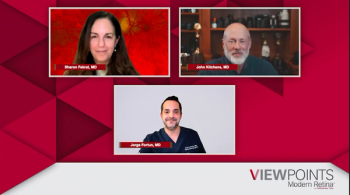
ARVO 2023: Using machine learning to identify visual field loss in optic neuritis
David Szanto, a medical student at Stony Brook, and working with the Department of Neurology at the Icahn School of Medicine at Mount Sinai, describes how an algorithm finds recurring patterns in the visual fields and the ganglion cell-inner plexiform layer thicknesses, and helps clinicians understand how prevalent those patterns are throughout the entire data.
David Szanto, a medical student at Stony Brook, and working with the Department of Neurology at the Icahn School of Medicine at Mount Sinai, describes how an algorithm finds recurring patterns in the visual fields and the ganglion cell-inner plexiform layer thicknesses, and helps clinicians understand how prevalent those patterns are throughout the entire data.
Szanto sat down with Sheryl Stevenson, Group Editorial Director with Ophthalmology Times®/Modern Retina®, to discuss the key takeaways from his presentation at the 2023 ARVO meeting, April 23 to 27, in New Orleans, Louisiana.
Video transcript
Editor’s note: This transcript has been edited for clarity.
Sheryl Stevenson: We're joined today by David Szanto, a medical student at Stony Brook, who is working with the Department of Neurology at the Icahn School of Medicine at Mount Sinai. Welcome to you, David. We're so excited to learn more about the ARVO presentation. Can you tell us a little about machine learning and the visual field loss outcomes that you are discovering?
David Szanto: Sure. Thank you for meeting with me, Sheryl. This work has been a collaboration [among] the Departments of Ophthalmology and Neurology at the Icahn School of Medicine; Bioengineering and Neuro-ophthalmology at the University of Iowa; Computational Mathematics at the Schepens Institute at Harvard; and the Cork University Hospital in Ireland. Our group is investigating machine learning and other methods to better understand the structure-function relationship of non-glaucoma optic neuropathies. Our research focuses on optic neuritis, which is inflammation of the optic nerve. Clinically, we know that it affects the central visual field and it's associated with thinning of a layer of the macula called the ganglion cell-inner plexiform layer, or GCIPL.
We've been using an unsupervised machine learning algorithm called archetypal analysis to subclassify the types of optic neuritis with both a 10-2 visual field, which focuses on the central visual field and by the GCIPL layer. To my knowledge, we're the first study to do so.
The algorithm creates some number of archetypes, such that each data point in the dataset can be made up of these archetypes. This is a very simple example but imagine that archetype A is a completely normal visual field and archetype B is major vision loss throughout the entire field. A data point that corresponds to a maybe pretty good but not completely normal visual field might be something like 80% archetype A and 20% archetype B.
What the algorithm does is that it finds recurring patterns in the visual fields and the GCIPL thicknesses, and it lets us know how prevalent those patterns are throughout the entire data.
We find that with almost all eyes with optic neuritis, at least 90 days after an acute optic neuritis attack, they nearly completely recovered their central visual fields comparable to the normal other eye. We also found that eyes with optic neuritis have a significantly thinner GCIPL layer.
Because the same visual fields can be found with pretty different GCIPL thicknesses, we found only a moderate correlation between structure, which is the GCIPL thickness, and function, which is the visual fields.
Interestingly, when we zeroed in on eyes that didn't recover their vision after an acute attack, we found 3 distinct visual field patterns of loss. These patterns were especially well correlated with specific patterns of GCIPL thickness. We can moderately correlate structure and function when vision recovery is good, but we correlate poor vision much better. We think that there's some sort of threshold of thinning, where initially there might be compensation due to overlapping receptor fields, or there's some sort of extra retinal processing. But after a critical mass of neurons are knocked out or thinned, there is persistent visual field loss. Clinically, we're anticipating by better understanding patterns of visual field and GCIPL loss, it will help us to better diagnose optic neuritis or even one day personalized treatment. Not all cases of optic neuritis present the same way.
Stevenson: Excellent. What are the key takeaways for the clinician, long term, looking into their practices maybe a few years from now?
Szanto: By figuring out these subtypes whether somebody might be 30% archetype A or 70% archetype C, that really helps us subclassify optic neuritis in ways that we haven't been able to do before. If we figure out that one subtype can be better treated one way than another, then we can really do that personalized treatment to target specific kinds of optic neuritis.
Newsletter
Keep your retina practice on the forefront—subscribe for expert analysis and emerging trends in retinal disease management.









































